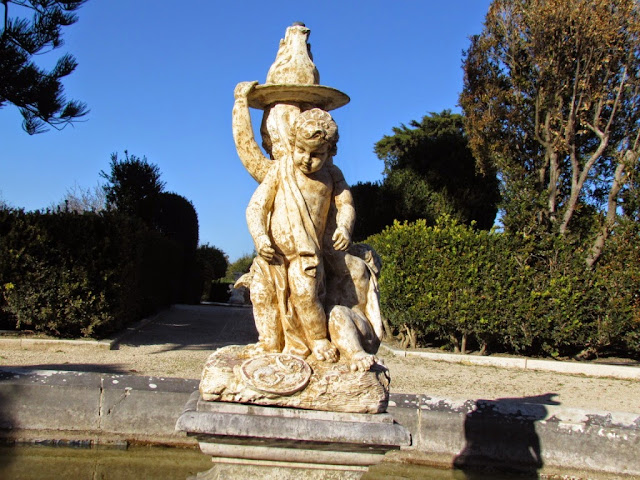DAFUNDO
AQUARIUM VASCO DA GAMA
(P) GPS N 38.69887 ; W 9.23734
(P) GPS N 38.69887 ; W 9.23734
The aquarium was inaugurated in 1898 with the support of D. Carlos I (1863-1908), and its main aim was to offer the visitor direct contact with the great riches of the aquatic world.
There is a very diversified collection of objects related to the oceanographic research promoted by D. Carlos.
The aquarium has 4000 specimens of marine fauna and flora from the world's various ecosystems.
There is a very diversified collection of objects related to the oceanographic research promoted by D. Carlos.
The aquarium has 4000 specimens of marine fauna and flora from the world's various ecosystems.
Tel 00 351 21 420 5000 aquariovgama@marinha.pt
Adress:
Rua Direita do Dafundo, 18
1495-718 Cruz Quebrada
OPEN EVERY DAY
10:00 - 18:00 (10.00 AM - 6.00 PM)
(2020 Tickets)
Children Free until (age): 3
Children: 2,50 €
Adult: 5 €
Family: 13 €
Senior: 2,50 €
HOW TO GET THERE:
- BY TRAIN- Railway line Lisboa ( Cais do Sodré) - Cascais, or Lisboa - Oeiras and get out the train at train station of Algés. Then, in the oposite direction of the river, in Algés, walk 10 minutes to your left.
Trains every 10 or 20 minutes( week end)
LISBON (CAIS DO SODRÉ) RAILWAY STATION - GPS N 38.70593 ; W 9.14393
-BY BUS - 76 till Dafundo. Or Buses 723, 729, 750, 751 till Algés. After take the bus 76
CRUZ QUEBRADA
Cruz Quebrada - Dafundo is a village and an old Portuguese parish in the municipality of Oeiras, with an area of 3.00 km² and 6 393 inhabitants (2011). Its population density was 2,131 inhab / km².
CAXIAS
( LISBOA - CASCAIS )
( P 2 ) GPS N 38.69867 ; W 9.27622
( CASCAIS - LISBOA)
CAXIAS TRAIN STATION
FORT OF SÃO BRUNO
 |
| Forte de São Bruno - Caxias - W Lisboa GPS N 38.69857 ; W 9.27489 QUINTA REAL DE CAXIAS ***** |
FORT OF SÃO BRUNO
GPS N 38.69857 ; W 9.27489
QUINTA REAL DE CAXIAS
free visit
GPS N 38.69969 ; W 9.27479
The "Quinta Real de Caxias", or "Jardim da Cascata", or "Gardens of Quinta Real de Caxias", is the main park in Caxias, Oeiras.
It is a walking space created around the gardens of the Royal Palace of Caxias, being an example of the Recreational Gardens that characterize Oeiras, and currently one of the elements of greatest architectural and historical interest. It is a unique example in the panorama of garden art due to the architectural, sculptural and allegorical value of the ensemble of the waterfall, viewpoint and sculptural groups. His sculptures by Machado de Castro are surrounded by a Versailles-style environment.
PAÇO DE ARCOS
Paço de Arcos is where "Quinta da Fonte" is located, one of the biggest office parks in Europe, being the home of companies such as DLL Group, Hewlett Packard, among others.
PAÇO DE ARCOS FOUNTAIN( *****)
Fountain dating from 1775, being one of the last works of the Government of Pombal. In 50 years was totally coated tiles depicting the discoveries.
Difficult external parking
GPS N 38.69653 ; W 9.28670
OEIRAS

Oeiras is a municipality in the western part of Lisbon metropolitan area, a subregion of Greater Lisbon, in continental Portugal. It is part of the urban agglomeration of Lisbon, 16 km from the capital. The population in 2011 was 172,120 living in an area of 45.88 km2, making the municipality the fifth-most densely populated in Portugal.
Oeiras is an important economic hub, being one of the most highly developed municipalities of Portugal and Europe. It has the highest GDP per capita in the country, being also the second highest municipality (immediately after Lisbon) in terms of purchasing power as well as the second one collecting taxes in the country. These economic indicators also reflect the education level of the inhabitants, as Oeiras is the municipality with the highest concentration of population with higher education in the country. It also has the lowest unemployment rate in the Lisbon area.
By the end of the 1980s, however, Oeiras began to constitute its own economic pole in the Lisbon metropolitan area, concentrating its development on tertiary activities linked to science, investigation, information technology and communications. At the end of the 20th century, the municipality became known for its high standard of living, leaving behind its image as a suburb of Lisbon and assuming an important position as a centre associated with new technologies (with the establishment of various technology parks, such as Taguspark and LagoasPark) and service industries. The elevated standard of living and work allowed the region to obtain several awards, including the Best Municipality to Work, Municipal Excellence' Award, European Enterprise Award and the ECOXXI Award.
(P) Historical center GPS N 38.69377 ; W 9.31089
 |
The best way to reach the spectacular sea promenade is, for those arriving on the LISBON - CASCAIS train, get off at Santo Amaro train station and walk 500 meters in the direction of the sea. |
"JARDIM DOS 7 CASTELOS" (Garden) , NEXT TO SANTO AMARO TRAIN STATION
THE SEA PROMENADE OF OEIRAS ( PASSEIO MARÍTIMO DE OEIRAS)



.JPG)










































































































































































.JPG)





























































































































































































































